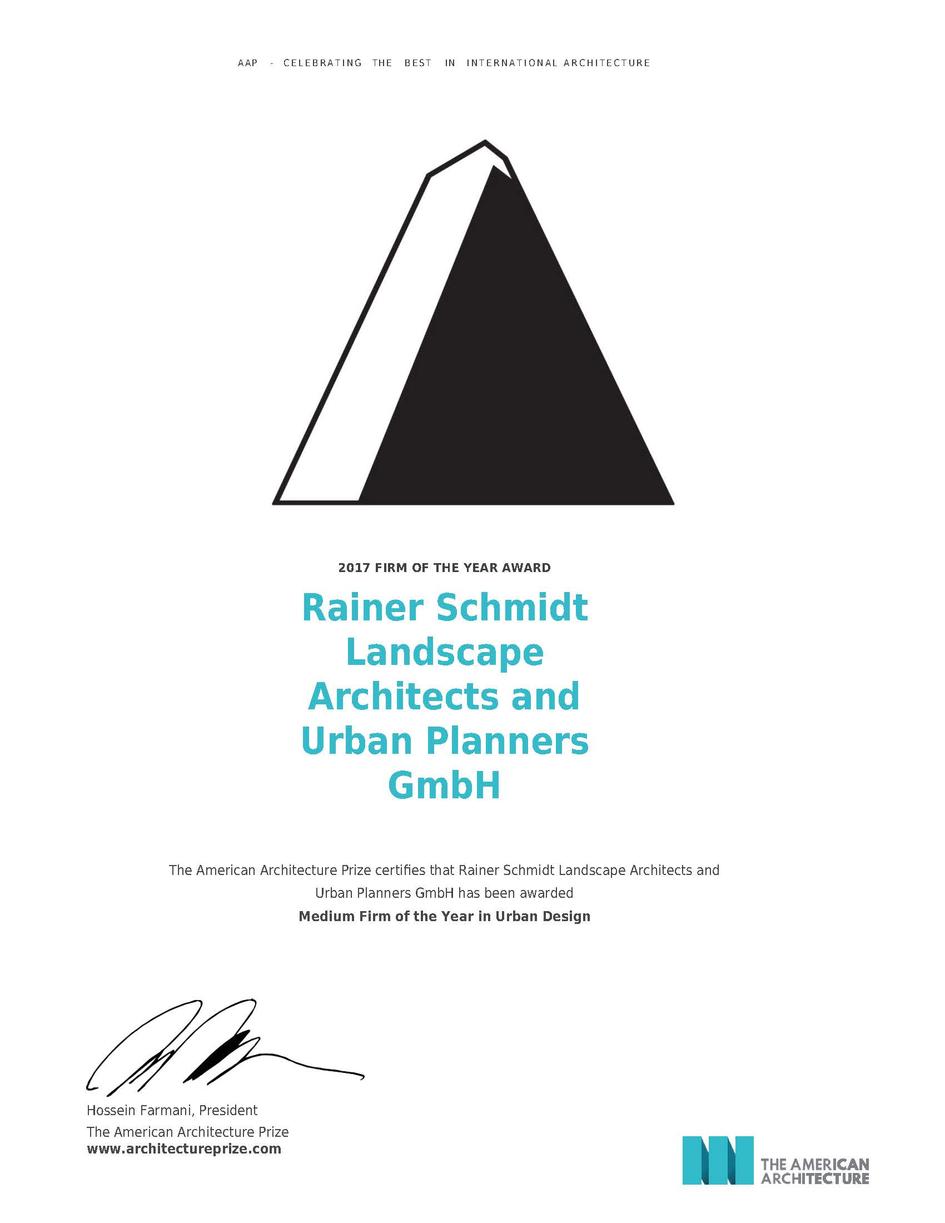4 August 2017, Rainer Schmidt Landscape Architects and Urban Planners have received the "AAP - American Architecture Prize 2017: Medium Firm of the year" COMPANY CULTURE „HEALING LANDSCAPE“ „Healing landscape“ – as element of space and equally as highest cultural good of our societies - generates the human well-being in exchange with the perception of nature, prevents from diseases and can – alongside the turn of the times of year – carry this well-being also in the long term, if the spaces of these landscapes, their vegetation and their atmospheres are appropriate, have been protected and are cared for. Equally, the healing landscape is a factor of relaxation in everyday life and counterbalance towards work and stress. Conceptualizing and implementing such a quality successfully demands a feeling for the profile between space and its offers for perception. “Healing Landscape” – as philosophy – follows an holistic approach. It is about appreciation, maintenance, care, form-giving and equally re-structuring of the cultural landscapes of built and un-built spaces. Both the sides are an expression of the need for a multi-disciplinary solution within the regionally and locally specific context. This philosophy reviews a history of about 50 years. It was started with the crisis of industrialization, the statements about the boundaries of quantitative urban gentryth and the exploitation of natural resources for the benefit of separating, expanding and concentrating functions in settled areas. During the 1970ies, “landscape urbanism” became consequently called into being as a framework for holistic design and planning of urban spaces. This framework remained subordinate to the premises of industrialization until the beginning of the 21st century, as far as these ones dominated regionally and locally. Global knowledge has searched for paths to strengthen this framework and has found titles for specific directions like “Infrastructure Urbanism” – “Strategic Urbanism” etc. Landscape and open spaces have found appreciation for a new understanding of the tasks for protecting and developing “nature”, respectively to what has been left from it by civilization during the processes of industrial development, in the publication of Gilles Clement Clément “Third Landscape”1) This publication distinguishes the “first landscape” as un-damaged and natural, the “second landscape” as industrially already damaged “nature” and the “third landscape” as our current field for working, demanding equally the preventative counter-balance of damages to occur by exploiting nature and the post-processing of already existing damages. The work of Rainer Schmidt Landscape Architects and urban planners starts historically herewith and has gained - with numerous projects since the end of the 1970ies - precise responses towards the path-leading implementation of these tasks: for „healing landscapes“ as well as for generating „healing landscapes“. The most important approach towards a successful solution of these tasks has been expressed by the publications of Rainer Schmidt about “nature by culture”, indicating, that “nature” – or what has been left from it – can only be qualified by means of cultural intervention. This becomes obvious in the publication „City by landscape“2) about the work of Rainer Schmidt in cooperation with Architects and engineers. Space is made to build a dialogue with perception , responding by well-being and reflecting to the structural offers for the occupation of space. Rainer Schmidt Landscape Architects and urban planners conceptualize the profiles for space and well-being for different places in the world since many years. Essential challenges of the present lie herewith in China and in the Arabic World where industrialization offers respectively different stages for design intervention, different from Europe, and where perception has traditions and desires, different from Europe. However, Europe having been marked by the “Enlightenment”, has been and still is a wonderful basis for an ever-lasting task of “healing landscape” sustainable and creatively. 1 C. Clément (2004), Manifest der Dritten Landschaft, Merve, Berlin 2 Th. Schröder (2013) (ed.), City by Landscape, Birkhäuser, Basel
